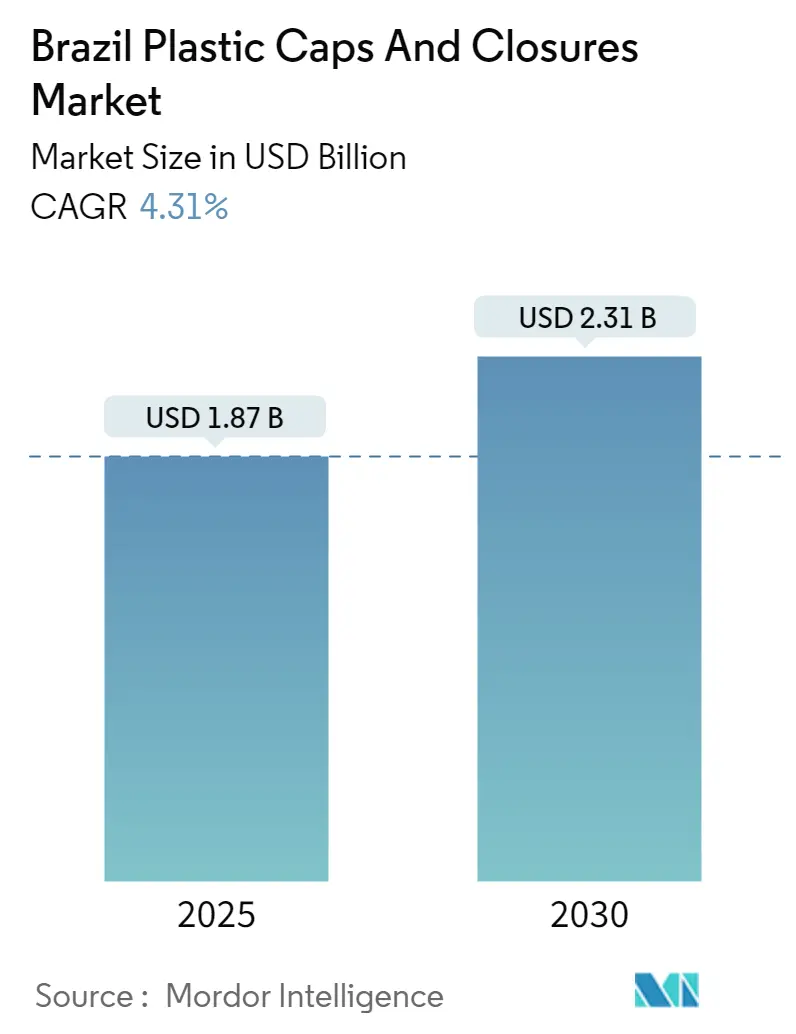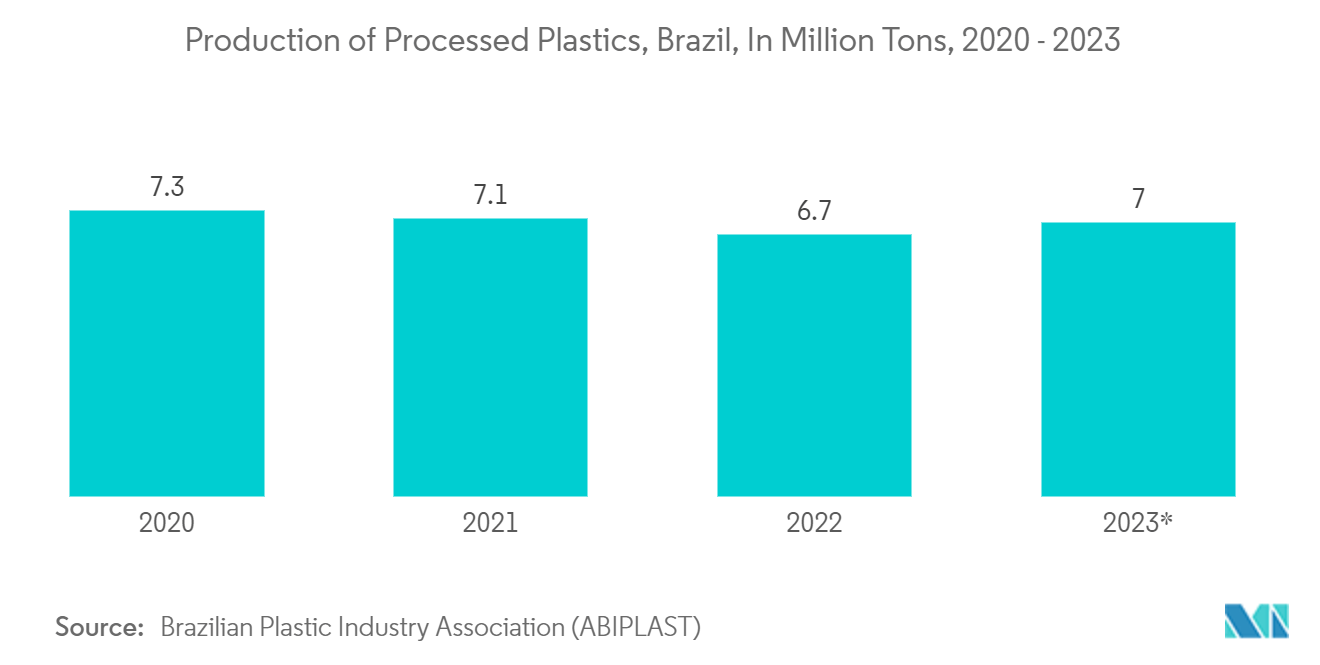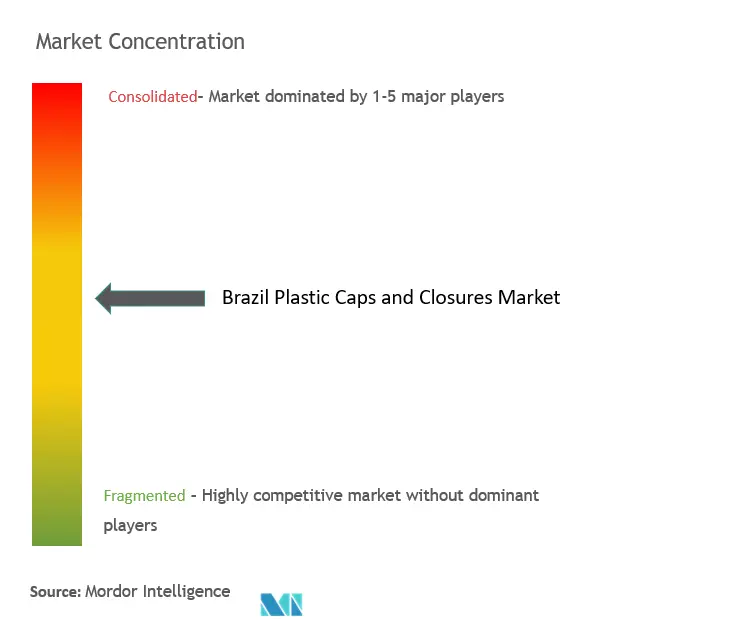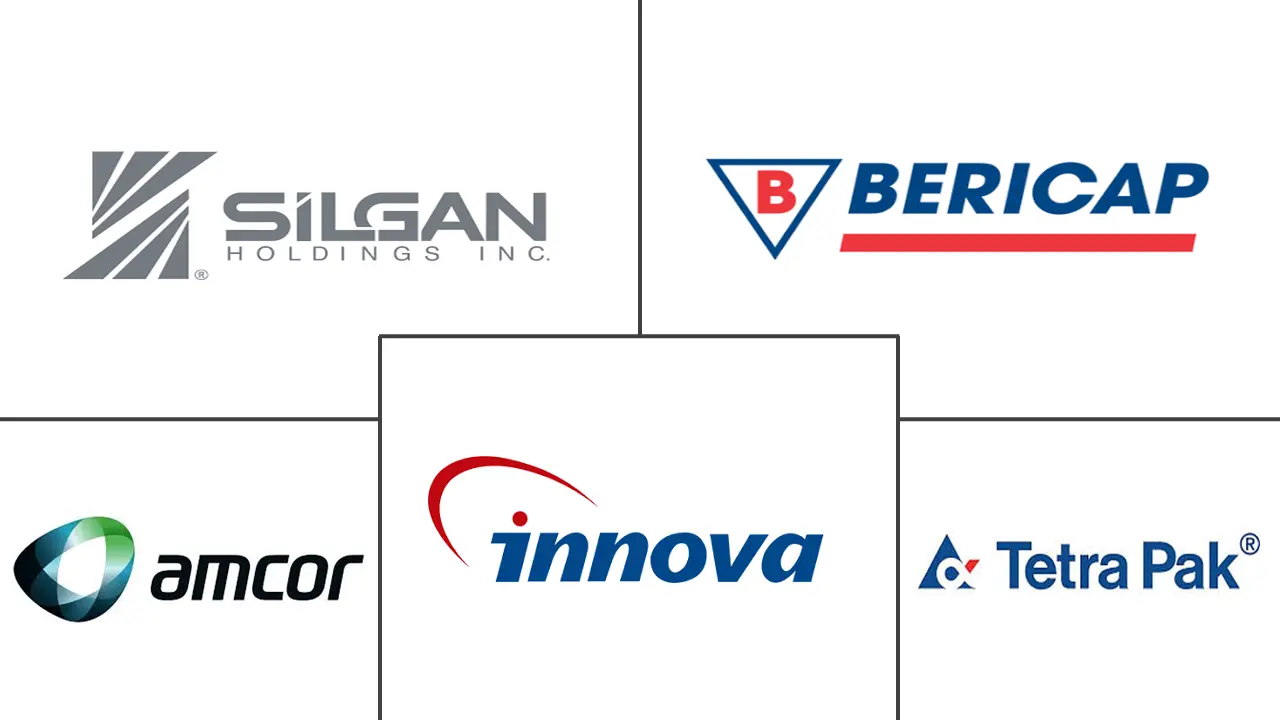Brazil Plastic Caps And Closures Market Size and Share

Brazil Plastic Caps And Closures Market Analysis by Mordor Intelligence
The Brazil Plastic Caps And Closures Market size is worth USD 1.87 Billion in 2025, growing at an 4.31% CAGR and is forecast to hit USD 2.31 Billion by 2030.
- Plastic caps and closures play a crucial role in sealing bottles and safeguarding their contents from contamination or spillage. The Brazilian market for these products is poised for growth, driven by their ability to create airtight seals, ensuring the integrity of stored goods. These closures are prized for their convenience, durability, and versatility, finding applications across food, beverages, personal care, and household products.
- The surge in demand for personal care items in Brazil, especially those utilizing dispensing and pump closures for spill-proof makeup solutions, is a key driver of market expansion. Furthermore, the increasing embrace of international cosmetic brands like L'Oreal, Estee Lauder, and Shiseido in Brazil significantly bolsters sales of caps and closures. Notably, a report from L'Oreal highlights robust growth in makeup, skincare, and haircare segments in both online and offline platforms in Brazil and Mexico, further fueling market momentum.
- Brazil's escalating food and ingredient imports, attributed to a growing population, surging tourism, and rising disposable incomes, are noteworthy. Data from the USDA underscores this trend, revealing a 12% increase in 2023, with consumer-oriented imports hitting USD 5.8 billion, up from the previous year.
- However, the rising environmental consciousness surrounding plastic packaging, which contributes significantly to landfill waste and pollution, is dampening the demand for plastic caps and closures. Consequently, many manufacturers are pivoting toward metal alternatives for making caps and closures, a shift that's reshaping the market landscape.
Brazil Plastic Caps And Closures Market Trends and Insights
Polyethylene (PE) is Estimated to Have the Largest Market Share
- Polyethylene (PE), a polyolefin resin, is used primarily to produce plastic caps and closures. The market is witnessing growth, propelled by PE's attributes of flexibility, durability, and tear resistance. Moreover, the material's ease of manufacturing and cost-effectiveness have led to increased adoption by manufacturers in Brazil, further fueling market expansion.
- Within Brazil, HDPE and LDPE stand out as the dominant materials for crafting caps and closures. HDPE, in particular, is favored for sealing water, dairy, energy drinks, and juice bottles. Notably, owing to its excellent organoleptic properties, polyethylene has emerged as the preferred choice for water bottle closures in the country. Noteworthy manufacturers like Bericap Holding GmbH are introducing HDPE closures with DoubleSeal technology, enhancing sealability and incorporating safe venting features, especially for carbonated beverages.
- Key players in Brazil, such as Amcor Group GmbH and Bericap Holding GmbH, are emphasizing tailored solutions for caps and closures. These customized offerings, often featuring unique colors and designs, are crafted from Polyethylene (PE), further propelling the market’s growth and enhancing brand recognition.
- Brazil's surging demand for plastics, driven by sectors like construction, packaging, and automotive, is a significant factor in the market's growth trajectory. Data from the Brazilian Plastic Industry Association (ABIPLAST) highlights that in 2023, the country's primary resin consumption included Polypropylene (PP), High-density Polyethylene (HDPE), and Polyvinyl Chloride (PVC). Notably, the production of processed plastics in 2023 reached an estimated 7 million tons, marking a notable 4.48% increase from the previous year.

Beverage Segment to Dominate the Market
- The growing demand for plastic caps and closures in the beverage segment is attributable to the increasing disposable income of the population coupled with the growing urbanization in Brazil. Soft drinks, commonly referred to as soda or carbonated beverages, form a significant segment within the non-alcoholic beverage industry. Comprising water, sugar, artificial sweeteners, and flavoring agents, their widespread appeal is set to drive up the demand for beverage caps and closures in the country.
- Changing consumer preferences in Brazil, particularly a shift toward low-calorie and zero-sugar carbonated drinks, have spurred a surge in soft drink flavors. This trend, driven by health-conscious individuals, is notably reshaping the market landscape. In response, Coca-Cola, a prominent US brand, has launched orange and grape variants of its iconic Coke in Brazil.
- Simultaneously, Brazil's burgeoning tourism and changing consumer tastes have led to a notable uptick in premium bottled water consumption. Brazilian consumers are increasingly drawn to bottled water for its health benefits and the absence of artificial additives.
- Moreover, Brazil's escalating export of non-alcoholic beverages, including flavored water, juices, and milk, is a pivotal driver of the market’s growth. In 2023, Brazil's exports of non-alcoholic beverages, as reported by the International Trade Centre (ITC), reached USD 36.35 million, marking a 21.26% increase from the previous year.

Competitive Landscape
The Brazilian plastic caps and closures market is moderately consolidated with domestic players such as Innova S/A and international players such as Amcor Group GmbH, Silgan Holdings Inc., and Sonoco Products Company. The players in the market focus on new product development, partnerships, mergers and acquisitions, and collaborations to solidify their footprint in the Brazilian market.
• April 2024: Bericap Holding GmbH, a Germany-based company operating in Brazil, announced its investment in a new plant in Kunshan, a city in Jiangsu province in China. The expansion is expected to increase the company's manufacturing capacity by 50% to cater to the growing consumer demand.
Brazil Plastic Caps And Closures Industry Leaders
-
Silgan Holdings Inc.
-
Bericap Holding GmbH
-
Amcor Group GmbH
-
Innova S/A
-
Tetra Pak International S.A
- *Disclaimer: Major Players sorted in no particular order

Recent Industry Developments
- July 2024: Silgan Holdings Inc., a United States-based company with operations in Brazil, announced the acquisition of Weener Plastics Holdings B.V., a Dutch company specializing in dispensing solutions for personal care, food, beverages, and healthcare. This move is set to bolster Silgan's closures division, broaden its product portfolio, and enhance its foothold in burgeoning consumer markets, thereby solidifying customer ties.
- January 2024: Valgroup, a Brazil-based plastic manufacturer, announced the acquisition of Mirvi Brasil, a Brazilian caps and closure manufacturer. The acquisition is expected to expand Valgroup's product portfolio in this segment and strengthen its position in the Brazilian market.
Brazil Plastic Caps And Closures Market Report Scope
The scope of the study characterizes the plastic caps and closures market based on the raw material of the product, including PP, PE, PET, and other raw materials used across various end-user industries such as food, pharmaceuticals, beverages, cosmetics, toiletries, and more across the country. The research also examines underlying growth influencers and significant industry vendors, all of which help to support market estimates and growth rates throughout the anticipated period. The market estimates and projections are based on the base year factors and arrived at top-down and bottom-up approaches.
The Brazilian plastic caps and closures market is segmented by resin (polyethylene (PE), polyethylene terephthalate (PET), polypropylene (PP), and other plastic materials), by product type (threaded, dispensing, unthreaded, and child-resistant), by end-use industries (food, beverage (bottled water, carbonated soft drinks, alcoholic beverages, juices and energy drinks and others), personal care and cosmetics, household chemicals, and other end-use industries). The market sizing and forecasts are provided in terms of volume (units) and revenue (USD) for all the above segments.
| Polyethylene (PE) |
| Polyethylene Terephthalate (PET) |
| Polypropylene (PP) |
| Other Plastic Materials (Polystyrene, PVC, Polycarbonate, etc.) |
| Threaded |
| Dispensing |
| Unthreaded |
| Child-resistant |
| Food | |
| Beverage | Bottled Water |
| Carbonated Soft Drinks | |
| Alcoholic Beverages | |
| Juices & Energy Drinks | |
| Other Beverage | |
| Personal Care & Cosmetics | |
| Household Chemicals | |
| Other End-Use Industries |
| By Resin | Polyethylene (PE) | |
| Polyethylene Terephthalate (PET) | ||
| Polypropylene (PP) | ||
| Other Plastic Materials (Polystyrene, PVC, Polycarbonate, etc.) | ||
| By Product Type | Threaded | |
| Dispensing | ||
| Unthreaded | ||
| Child-resistant | ||
| By End-Use Industries | Food | |
| Beverage | Bottled Water | |
| Carbonated Soft Drinks | ||
| Alcoholic Beverages | ||
| Juices & Energy Drinks | ||
| Other Beverage | ||
| Personal Care & Cosmetics | ||
| Household Chemicals | ||
| Other End-Use Industries | ||
Key Questions Answered in the Report
How big is the Brazil Plastic Caps And Closures Market?
The Brazil Plastic Caps And Closures Market size is worth USD 1.87 billion in 2025, growing at an 4.31% CAGR and is forecast to hit USD 2.31 billion by 2030.
What is the current Brazil Plastic Caps And Closures Market size?
In 2025, the Brazil Plastic Caps And Closures Market size is expected to reach USD 1.87 billion.
Who are the key players in Brazil Plastic Caps And Closures Market?
Silgan Holdings Inc., Bericap Holding GmbH, Amcor Group GmbH, Innova S/A and Tetra Pak International S.A are the major companies operating in the Brazil Plastic Caps And Closures Market.
What years does this Brazil Plastic Caps And Closures Market cover, and what was the market size in 2024?
In 2024, the Brazil Plastic Caps And Closures Market size was estimated at USD 1.79 billion. The report covers the Brazil Plastic Caps And Closures Market historical market size for years: 2019, 2020, 2021, 2022, 2023 and 2024. The report also forecasts the Brazil Plastic Caps And Closures Market size for years: 2025, 2026, 2027, 2028, 2029 and 2030.
Page last updated on:
Brazil Plastic Caps And Closures Market Report
Statistics for the 2025 Brazil Plastic Caps And Closures market share, size and revenue growth rate, created by Mordor Intelligence™ Industry Reports. Brazil Plastic Caps And Closures analysis includes a market forecast outlook for 2025 to 2030 and historical overview. Get a sample of this industry analysis as a free report PDF download.



